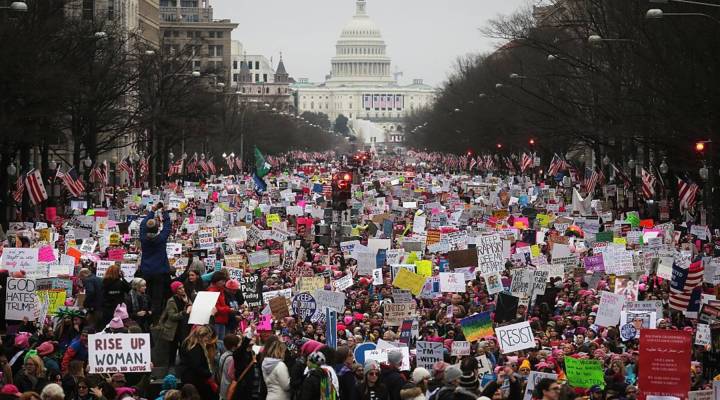
Blog: What the protest economy means to you

We’re less than two months into 2017, and already we’ve seen one of the largest days of protests in U.S. history, multiple cities divesting from a major bank and an endless list of boycotts proposed by President Donald Trump’s supporters and opponents alike. We’re in a constant state of protest, say Kai Ryssdal and Molly Wood on this week’s Make Me Smart, one that could very well last the next four to eight years.
So what does that mean for the economy? Hint: It goes beyond the widespread scarcity of pink yarn that occurred after the Women’s March, though Molly says that did happen.
Some of our listeners wrote in to share their stories of how they’ve observed protests informing their local economy, including Naomi, who works at a party store in Bethesda, Maryland:
Normally, January and February are our slowest months, enough that we even shorten our hours during this period. But the week before the women’s march was crazy. We sold out of almost all our posterboard (all white and most of the colors) and foam board, sold out of pink and pinkish yarn, and sold out of the large sizes of sharpies. At the hardware store next to us, they were running low on paint stirrers because everyone was taking them to use to hold up the signs. We’re still out of Elmer’s glue, and apparently, so are a number of stores near us.
Over in Utah, some small business owners are bracing for the opposite effects after the largest outdoor recreation trade show in the country announced it will not return to Salt Lake City in 2018 after 20 years there. The Outdoor Retailer show occurs biannually and buoyed local businesses.
Following the lead of Patagonia and other vendors, the show is pulling out of Utah in protest of Republican politicians’ fight against Bears Ears National Monument and other federally owned land they want turned over to the state.
Here’s a take on the situation from Kyle Vines, whose sustainable rock climbing gear business in Colorado stands to benefit if the trade show moves to the area:
[I]n 2018 there is a good possibility that Outdoor Retailer could move to Denver, Colorado. That is where our company is located. Having an event of this scale near our headquarters could be huge for our small business. We have our fingers crossed that the trade show will move here. It is crazy to think that Utah Official’s inaction and subsequent los[s] could potentially be our gain in a weird way.
So we know some small business owners have a stake in the protest economy, but what about entire cities? An Op-ed by Ben Cohen of Ben & Jerry’s written ahead of the 2004 Republican National Convention in New York City challenged the notion that protesters are a “ragtag bunch” and put it simply: “cash-carrying people are cash-carrying people.”
Cohen scolded then-Mayor Michael Bloomberg for not welcoming protesters alongside convention-goers and overlooking the revenue they’d bring to the city by way of hotel rooms, restaurants, transportation and other purchases.
If protesters were properly invited and assured of a safe place to protest, who knows how many would come? Two million? Three million? This could translate into a billion dollars or more for the city.
Revisiting this article now, it’s hard not to think back to the women’s march on Jan. 21, a permitted event that brought in nearly a half million people — three times that of Inauguration attendees — and surely boosted Washington D.C.’s local economy for the weekend.
Get in touch on the “Make Me Smart” website with your own comments and questions for Kai and Molly.
There’s a lot happening in the world. Through it all, Marketplace is here for you.
You rely on Marketplace to break down the world’s events and tell you how it affects you in a fact-based, approachable way. We rely on your financial support to keep making that possible.
Your donation today powers the independent journalism that you rely on. For just $5/month, you can help sustain Marketplace so we can keep reporting on the things that matter to you.












